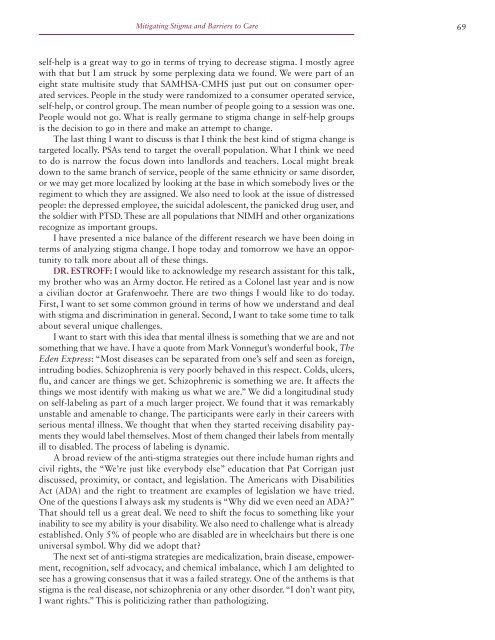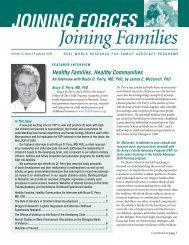stigma and barriers to care - Uniformed Services University of the ...
stigma and barriers to care - Uniformed Services University of the ...
stigma and barriers to care - Uniformed Services University of the ...
Create successful ePaper yourself
Turn your PDF publications into a flip-book with our unique Google optimized e-Paper software.
Mitigating Stigma <strong>and</strong> Barriers <strong>to</strong> Care 69<br />
self-help is a great way <strong>to</strong> go in terms <strong>of</strong> trying <strong>to</strong> decrease <strong>stigma</strong>. I mostly agree<br />
with that but I am struck by some perplexing data we found. We were part <strong>of</strong> an<br />
eight state multisite study that SAMHSA-CMHS just put out on consumer operated<br />
services. People in <strong>the</strong> study were r<strong>and</strong>omized <strong>to</strong> a consumer operated service,<br />
self-help, or control group. The mean number <strong>of</strong> people going <strong>to</strong> a session was one.<br />
People would not go. What is really germane <strong>to</strong> <strong>stigma</strong> change in self-help groups<br />
is <strong>the</strong> decision <strong>to</strong> go in <strong>the</strong>re <strong>and</strong> make an attempt <strong>to</strong> change.<br />
The last thing I want <strong>to</strong> discuss is that I think <strong>the</strong> best kind <strong>of</strong> <strong>stigma</strong> change is<br />
targeted locally. PSAs tend <strong>to</strong> target <strong>the</strong> overall population. What I think we need<br />
<strong>to</strong> do is narrow <strong>the</strong> focus down in<strong>to</strong> l<strong>and</strong>lords <strong>and</strong> teachers. Local might break<br />
down <strong>to</strong> <strong>the</strong> same branch <strong>of</strong> service, people <strong>of</strong> <strong>the</strong> same ethnicity or same disorder,<br />
or we may get more localized by looking at <strong>the</strong> base in which somebody lives or <strong>the</strong><br />
regiment <strong>to</strong> which <strong>the</strong>y are assigned. We also need <strong>to</strong> look at <strong>the</strong> issue <strong>of</strong> distressed<br />
people: <strong>the</strong> depressed employee, <strong>the</strong> suicidal adolescent, <strong>the</strong> panicked drug user, <strong>and</strong><br />
<strong>the</strong> soldier with PTSD. These are all populations that NIMH <strong>and</strong> o<strong>the</strong>r organizations<br />
recognize as important groups.<br />
I have presented a nice balance <strong>of</strong> <strong>the</strong> different research we have been doing in<br />
terms <strong>of</strong> analyzing <strong>stigma</strong> change. I hope <strong>to</strong>day <strong>and</strong> <strong>to</strong>morrow we have an opportunity<br />
<strong>to</strong> talk more about all <strong>of</strong> <strong>the</strong>se things.<br />
DR. ESTROFF: I would like <strong>to</strong> acknowledge my research assistant for this talk,<br />
my bro<strong>the</strong>r who was an Army doc<strong>to</strong>r. He retired as a Colonel last year <strong>and</strong> is now<br />
a civilian doc<strong>to</strong>r at Grafenwoehr. There are two things I would like <strong>to</strong> do <strong>to</strong>day.<br />
First, I want <strong>to</strong> set some common ground in terms <strong>of</strong> how we underst<strong>and</strong> <strong>and</strong> deal<br />
with <strong>stigma</strong> <strong>and</strong> discrimination in general. Second, I want <strong>to</strong> take some time <strong>to</strong> talk<br />
about several unique challenges.<br />
I want <strong>to</strong> start with this idea that mental illness is something that we are <strong>and</strong> not<br />
something that we have. I have a quote from Mark Vonnegut’s wonderful book, The<br />
Eden Express: “Most diseases can be separated from one’s self <strong>and</strong> seen as foreign,<br />
intruding bodies. Schizophrenia is very poorly behaved in this respect. Colds, ulcers,<br />
flu, <strong>and</strong> cancer are things we get. Schizophrenic is something we are. It affects <strong>the</strong><br />
things we most identify with making us what we are.” We did a longitudinal study<br />
on self-labeling as part <strong>of</strong> a much larger project. We found that it was remarkably<br />
unstable <strong>and</strong> amenable <strong>to</strong> change. The participants were early in <strong>the</strong>ir <strong>care</strong>ers with<br />
serious mental illness. We thought that when <strong>the</strong>y started receiving disability payments<br />
<strong>the</strong>y would label <strong>the</strong>mselves. Most <strong>of</strong> <strong>the</strong>m changed <strong>the</strong>ir labels from mentally<br />
ill <strong>to</strong> disabled. The process <strong>of</strong> labeling is dynamic.<br />
A broad review <strong>of</strong> <strong>the</strong> anti-<strong>stigma</strong> strategies out <strong>the</strong>re include human rights <strong>and</strong><br />
civil rights, <strong>the</strong> “We’re just like everybody else” education that Pat Corrigan just<br />
discussed, proximity, or contact, <strong>and</strong> legislation. The Americans with Disabilities<br />
Act (ADA) <strong>and</strong> <strong>the</strong> right <strong>to</strong> treatment are examples <strong>of</strong> legislation we have tried.<br />
One <strong>of</strong> <strong>the</strong> questions I always ask my students is “Why did we even need an ADA”<br />
That should tell us a great deal. We need <strong>to</strong> shift <strong>the</strong> focus <strong>to</strong> something like your<br />
inability <strong>to</strong> see my ability is your disability. We also need <strong>to</strong> challenge what is already<br />
established. Only 5% <strong>of</strong> people who are disabled are in wheelchairs but <strong>the</strong>re is one<br />
universal symbol. Why did we adopt that<br />
The next set <strong>of</strong> anti-<strong>stigma</strong> strategies are medicalization, brain disease, empowerment,<br />
recognition, self advocacy, <strong>and</strong> chemical imbalance, which I am delighted <strong>to</strong><br />
see has a growing consensus that it was a failed strategy. One <strong>of</strong> <strong>the</strong> an<strong>the</strong>ms is that<br />
<strong>stigma</strong> is <strong>the</strong> real disease, not schizophrenia or any o<strong>the</strong>r disorder. “I don’t want pity,<br />
I want rights.” This is politicizing ra<strong>the</strong>r than pathologizing.




